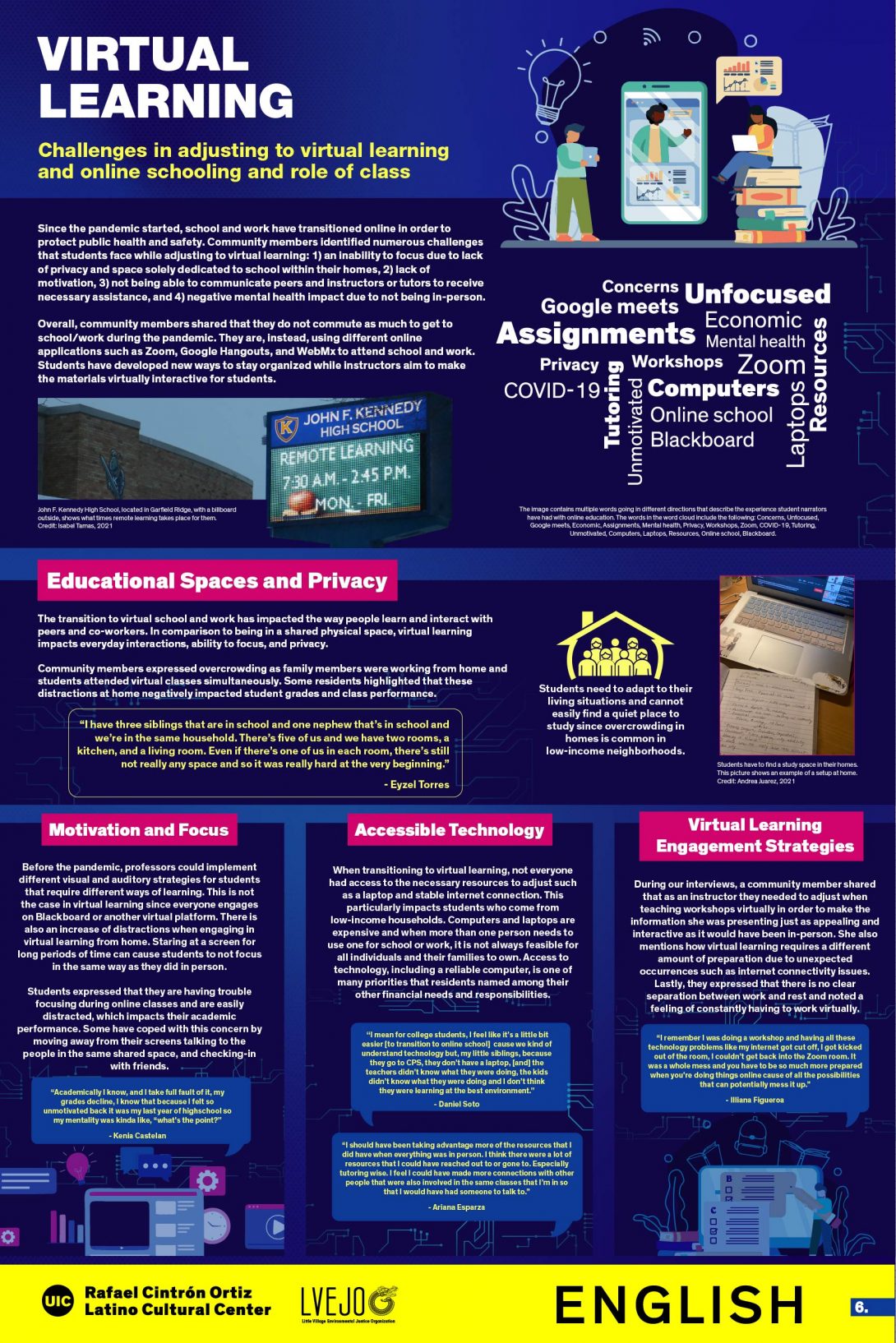Virtual Learning
Challenges in adjusting to virtual learning and online schooling and role of class
virtual learning Heading link

Since the pandemic started, school and work have transitioned online in order to protect public health and safety. Community members identified numerous challenges that students face while adjusting to virtual learning:
1) an inability to focus due to lack of privacy and space solely dedicated to school within their homes,
2) lack of motivation,
3) not being able to communicate peers and instructors or tutors to receive necessary assistance, and
4) negative mental health impact due to not being in-person.
Overall, community members shared that they do not commute as much to get to school/work during the pandemic. They are, instead, using different online applications such as Zoom, Google Hangouts, and WebMx to attend school and work. Students have developed new ways to stay organized while instructors aim to make the materials virtually interactive for students.
Word Cloud: Concerns, Unfocused, Google meets, Economic, Assignments, Mental health, Privacy, Workshops, Zoom, COVID-19, Tutoring, Unmotivated, Computers, Laptops, Resources, Online school, Blackboard.
Educational Spaces and Privacy
The transition to virtual school and work has impacted the way people learn and interact with peers and co-workers. In comparison to being in a shared physical space, virtual learning impacts everyday interactions, ability to focus, and privacy.
Community members expressed overcrowding as family members were working from home and students attended virtual classes simultaneously. Some residents highlighted that these distractions at home negatively impacted student grades and class performance.
“I have three siblings that are in school and one nephew that’s in school and we’re in the same household. There’s five of us and we have two rooms, a kitchen, and a living room. Even if there’s one of us in each room, there’s still not really any space and so it was really hard at the very beginning.” – Eyzel Torres
Students need to adapt to their living situations and cannot easily find a quiet place to study since overcrowding in homes is common in low-income neighborhoods.
Motivation and Focus
Before the pandemic, professors could implement different visual and auditory strategies for students that require different ways of learning. This is not the case in virtual learning since everyone engages on Blackboard or another virtual platform. There is also an increase of distractions when engaging in virtual learning from home. Staring at a screen for long periods of time can cause students to not focus in the same way as they did in person.
Students expressed that they are having trouble focusing during online classes and are easily distracted, which impacts their academic performance. Some have coped with this concern by moving away from their screens talking to the people in the same shared space, and checking-in with friends.
“Academically I know, and I take full fault of it, my grades decline, I know that because I felt so unmotivated back it was my last year of highschool so my mentality was kinda like, “what’s the point?” – Kenia Castelan
Accessible Technology
When transitioning to virtual learning, not everyone had access to the necessary resources to adjust such as a laptop and stable internet connection. This particularly impacts students who come from low-income households. Computers and laptops are expensive and when more than one person needs to use one for school or work, it is not always feasible for all individuals and their families to own. Access to technology, including a reliable computer, is one of many priorities that residents named among their other financial needs and responsibilities.
“I mean for college students, I feel like it’s a little bit easier [to transition to online school] cause we kind of understand technology but, my little siblings, because they go to CPS, they don’t have a laptop, [and] the teachers didn’t know what they were doing, the kids didn’t know what they were doing and I don’t think they were learning at the best environment.” – Daniel Soto
“I should have been taking advantage more of the resources that I did have when everything was in person. I think there were a lot of resources that I could have reached out to or gone to. Especially tutoring wise. I feel I could have made more connections with other people that were also involved in the same classes that I’m in so that I would have had someone to talk to.” – Ariana Esparza
Virtual Learning Engagement Strategies
During our interviews, a community member shared that as an instructor they needed to adjust when teaching workshops virtually in order to make the information she was presenting just as appealing and interactive as it would have been in-person. She also mentions how virtual learning requires a different amount of preparation due to unexpected occurrences such as internet connectivity issues. Lastly, they expressed that there is no clear separation between work and rest and noted a feeling of constantly having to work virtually.
“I remember I was doing a workshop and having all these technology problems like my internet got cut off, I got kicked out of the room, I couldn’t get back into the Zoom room. It was a whole mess and you have to be so much more prepared when you’re doing things online cause of all the possibilities that can potentially mess it up.” – Illiana Figueroa